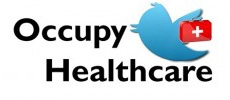Many of you who follow this site know that call to action was sent out by Dr. Mark Ryan. Essentially, Dr. Ryan asked readers of OH to share some of their ideas about healthcare and health reform. Below is one of our proposals from Wayne Caswell. – Ben
Occupy Healthcare – a proposal from Wayne Caswell, Modern Health Talk
Historically, the biggest impact in health outcomes has come from public health initiatives such as clean water, sewage systems, and immunization programs. But that success is minimized by a “sick care” system that is profoundly broken, with perverse incentives to view patients as customers, treat symptoms, and pay practitioners for each test, drug and procedure.
ACA is meant to fix that, with more emphasis on positive outcomes and overall health & wellness, both to minimize the need for medical care in the first place and thus reduce costs, and to maintain a healthy and productive workforce that contributes to a vibrant economy. ACA is a good start, but there’s still more work to be done, and it won’t come from private industry or the insurance model, because natural incentives prevent it.
Contrasting Incentives
I believe that the key to health reform is getting the incentives right, and that means getting private insurance companies out of BASIC health care entirely. Their profit motive gives them an incentive to increase costs, knowing that higher costs = more insurance customers paying higher premiums. What I propose instead is a hybrid public/private model that capitalizes on contrasting incentives, eliminates the need for health insurance, and saves over $1 trillion per year.
In a free-market society, private companies are most efficient when there’s vibrant competition on a level playing field, because that competition causes them to improve service & product quality and drive down prices. These private companies, answering to shareholders and driven by profit motives measure success in terms such as Revenue, ROI, Payback Period, Stock Price, etc.
Public entities measure success differently and over much longer time periods. As a result, they can make more strategic and longer-term investments and fund them with bonds and tax revenues. Their objectives can focus on lifestyle improvements, on nurturing that skilled, healthy and productive workforce, and on infrastructure as the engine of economic growth to benefit all. Some people see public services as generally having large and inefficient bureaucracies, but the public sector can actually be more cost effective, because there’s no need to make a profit, and their relatively large size is due to the scale of their operations.
The Hybrid, Public/Private Model
Under a public sector model for basic health care, doctors and nurses work as government employees. Basic services are provided at cost to all, including the poor, foreign visitors and illegal aliens, partially to prevent the outbreak of disease.
The added costs of today’s system should disappear or at least be diminished greatly. There would be no incentive to practice defensive medicine, and an oversight committee could monitor care and complaints. There would be no reason to pad bills or commit fraud since the doc makes the same money as an employee regardless of what they do with that patient. Thus they can focus on care, outcome and treatment only. And, there’s no need for Medicare or Medicaid or private insurance programs.
Anything beyond the basics can be addressed by private options that extend care. Examples might include retail clinics, dial-a-doc services, concierge services, and elective procedures. These private options would need less regulatory oversight and might even include medical tourism.
The public portion of this hybrid model, with its focus on health & wellness, would include education on smoking, nutrition, exercise and sleep, and also address the health effects of poverty & obesity. Smoking is important because it adds 20% to annual medical costs, and evidence shows the smoking cessation programs have generally worked. Even though some people still smoke, it’s far fewer than in the 1960′s.
Obesity adds at least 50% to medical costs, but they aren’t evenly distributed across social classes. According to HBO’s documentary “The Weight of the Nation,” public health officials can reliably predict a community’s weight by zip code and have noticed lifespan differences of more than 20 years between poor neighborhoods on one side of town and affluent ones on the other side just 8 miles away.
Billing at Cost
In the older HMO model where preventive care was free, and in the evolving insurance model afterwards, patients contributed to the abuse of the system, because they didn’t know about or have to worry about the cost of each test or procedure, until they were surprised by dozens of bills afterwards. But in the basic public health model, such abuse is discouraged because services are provided at cost, with total costs known up front, and no need for health insurance.
Expected Opposition
The $2.6 trillion in annual health care costs are going somewhere now. If a new model reduces that to half or less, then over $1 trillion can go into the economy elsewhere. But SOMEBODY is going to scream that they’re no longer getting their part of the $1 trillion that’s no longer being spent. That’s where the opposition will come from – the incumbents who will naturally and fiercely defend their current positions and oppose public health care initiatives.
They’ll argue that their profits and what they personally spend trickles down to others somehow.
More info on Wayne can be found on his website and through his Twitter account.
